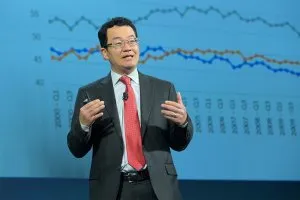During World War II, Muskegon, Mich., was a relatively small city. But it was an industrial powerhouse, with Continental Motors building more than 100,000 engines in its huge factory for the U.S. military’s tanks and airplanes.

At its peak in 1944, the company employed 11,000 workers in Muskegon, earning it the nickname “Arsenal of Democracy.” It was so important to the war effort, historians say, that when Nazi planners drew up orders to bomb key targets in the United States, the Midwest city had the dubious distinction of making a “Top 10” list.
But Muskegon, which remains the largest city on the eastern shore of Lake Michigan, began losing residents within years after WWII ended. Its population, which peaked at 50,000, has declined roughly 20 percent since then.
And Continental Motors, now Continental Aerospace Technologies, left Muskegon in the 1980s. It’s currently based in Mobile, Ala., and has a mere 375 employees.
Muskegon’s Turnaround
In recent years, though, Muskegon, which brands itself as “Shoreline City,” has begun to rebound. It’s now using Tax Increment Financing (TIF) as a way to fund housing for low- and middle-income residents.
Jake Eckholm, Muskegon’s director of development services describes TIF as a “powerful tool” that helps cover costs associated with redeveloping blighted properties.
A TIF is generally defined as a special financing method available to municipalities that spurs economic development which otherwise would not occur.
Muskegon is just one of many cities around the country that are using TIF and other so-called value capture efforts to finance affordable housing, downtown redevelopments, transit and other projects. They range from business improvement districts (BIDs) to special parking fees and even selling the naming rights for stadiums to fund programs.
TIFs used for data centers
In some areas, however, TIF subsidies have been used for controversial developments that critics say have burdened local governments with debt, displaced residents and businesses and subsidized already profitable entities, rather than focusing on smaller, community building projects. Others criticize them for lack of transparency compared to other taxing mechanisms and tools.
Likewise, the use of TIF for huge data centers to process artificial intelligence for the likes of Microsoft and Meta has drawn scrutiny from watchdog groups. Microsoft has a net worth of nearly $4 trillion, while Meta, which owns Facebook, is worth $2 trillion. They also question the environmental impact of the projects, which will use massive amounts of electricity and water. But the rush is on by states competing with each other to lure data centers as part of their economic development programs.
In July, Wisconsin Gov. Tony Evers, a Democrat, signed a bipartisan bill that creates exemptions for TIF districts and offers other incentives. Among other sites, the legislation supports proposed data centers in Beaver Dam, north of Madison; Port Washington, on Lake Michigan; and Menomonie in western Wisconsin. Combined, these three data centers alone would be worth more than $10 billion.
But TIF districts carry risks if projects stumble or the economy goes into a slump, according to a League of Wisconsin Municipalities assessment. And that means, taxpayers could be left paying the bill for infrastructure improvements if revenues from the project don’t materialize.
Matthew P. Dregne, a partner at Stafford Rosenbaum law firm in Madison, Wis., put it this way: “All TIF projects have one important feature in common. They depend on private development to increase the assessed value of taxable property. In a TIF district, the tax revenue generated by that increase in value is the economic engine that pays the bills. Most of the risks involved in TIF projects stem from the risk that anticipated private development will fall short of expectations. If anticipated tax revenue fails to materialize, then, without adequate safeguards, taxpayers will be left paying the bill.”
Greg LeRoy, executive director of Good Jobs First (GJF) — a national policy resource center that promotes corporate and government accountability in economic development — said Wisconsin was “foolish” to create a special TIF district exception for data centers.
He called them big, net tax revenue losers that have created few permanent jobs around the country. “Data centers are driving electricity rates up, forcing consumers to pay for generating capacity for trillion-dollar companies.”
LeRoy is also critical of Wisconsin for giving data center companies sales and use tax exemptionspdf, especially those that lack sunset provisions. A GJF report earlier this year said at least 10 states already lose more than $100 million per year in tax revenue to data centers.
Another GJF study found that 15 data center sales and use exemption programs across the country “drained a small number of communities of almost $1.5 billion” in revenue in 2023. “We know of no other form of state spending that is so out of control. Therefore, we recommend that states cancel their data center tax exemptions,” the report said. “Such subsidies are absolutely unnecessary for an extremely profitable industry dominated by some of the most valuable corporations on earth.”
In Port Washington, Wis., however, Mayor Ted Neitzke is bullish on his community’s proposed data center. Neitzke said he believes it could more than “double the valuation” of the city, boosting the city’s tax revenue to improve local services while also providing relief to local taxpayers.
“That could potentially cut personal property taxes in half,” he told Wisconsin Public Radio (WPR). “Our city would be able to be in a really strong position for our schools, our kids, our seniors, everybody.”
Menomonie Mayor Randy Knaack sees things differently. He said the proposed data center is too big for his community of 16,000 on the Red Cedar River. He is also skeptical of recent changes to state law that significantly reduce how much tax revenue the city would get from the data center.
But he estimated the city would still get around $1.7 million annually in tax revenues from the proposed artificial intelligence project. “That would certainly help out the city budget,” Knaack told WPR. “But as far as the pros and the cons, my opinion is that the cons outweigh the pros several times over.”
Use of TIFs for affordable housing
In Muskegon, which is using TIF on a much smaller scale, Eckholm said his city began facing a potential housing shortage as people started to move back into town in recent years, drawn by the city’s popular public beaches on Lake Michigan, museums, festivals, parks, trails and other amenities.

“The arts and cultural environment is amazing here. And the food scene has come a long way in the last decade, too. Plus, we have some nice neighborhoods with a lot of character and charm. We’re getting an influx of residents who are moving here because the housing markets near us are much more expensive,” added Eckholm, a Muskegon native.
Muskegon, Mich., has added several hundred new residences using TIF subsidies.
He said a study indicated that in coming years, the city would need to build more units at every price point: roughly 1,600 rentals and 1,323 owner occupied houses. “It showed that we were facing a projected gap of 20 percent deficit, which is one of the most severe that I’ve ever seen. And, I’ve looked at a lot of these studies.”
Over the past six years, he said Muskegon has added several hundred new residences using TIF subsidies. Many of them are inexpensive, 1,000-square foot, two-bedroom, one-bath “efficiency homes” built for around $160,000. “We think we have the most affordable stick-built, site-built construction in the country. These are true ‘starter’ residences, ones that aren’t getting put up much anywhere, if at all. And because we’re using TIF and offering grants, we can market those homes for a discount of around $129,900.”
TIF has provided financing for more than 15 affordable housing developments.
With a current (as of September) interest rate of around 6.5 percent on a 30-year, fixed-rate U.S. mortgage, a homeowner would pay only $823 a month on a $130,000 mortgage. Insurance and property taxes would be extra. “If you can find another place in the country that has new construction, site-built houses for less than $130,000, I’d love to talk to them. But we haven’t been able to find anyone else doing it. And this has not cost the taxpayers here a dime.”
As a result, formerly empty lots that were overgrown with weeds are now homes occupied by low- and middle-income working families who have planted flower and vegetable gardens in their yards. Eckholm called those changes a boon for the city and a significant boost for its civic pride.
Edward Erfurt, an architect and urban planner who is the chief technical advisor for Strong Towns, lauded Muskegon for its use of TIF to build affordable housing.
“We don’t believe everyone uses TIF the right way and some are taking on big risks,” he said. “But Muskegon has one of the best and most robust affordable housing TIF programs.”
Mixed uses in Milwaukee
In Milwaukee, on the Wisconsin side of Lake Michigan, the Department of City Development (DCD) recently announced plans to use TIF for a project that will renovate a foreclosed commercial building on Dr. Martin Luther King Jr. Drive for housing. Another would repurpose an underused office building in downtown Milwaukee that would feature workforce housing.

Since 2018, the DCD has used TIF to provide financing for more than 15 affordable housing developments, according to city records. The department has proposed a $14.4-million investment to support a plan to redevelop the 100 East Wisconsin Ave. property, which will convert the office building into 373 new units. Included are 75 workforce housing units for those earning equal or less than the city’s area median income. The total estimated development cost is around $165 million.
City officials said the conversion advances the Connecting MKE Plan 2040 goals of doubling the downtown population and having a wider mix of uses in the area. Klein Development and developer John Vassallo owns the 100 East building, which was built in 1989. His team had been pushing for the project for several years. Recently, a board approved the project for federal and state historic tax credits.
Vassallo called Milwaukee “ahead of the curve nationally [and] recognizing the need to get creative and find a solution to repurpose obsolete buildings.”
Milwaukee officials have also recommended investing $1.37 million in Compass Lofts, a mixed-use development with affordable housing units. The project is located on a city-owned tax foreclosed property on Martin Luther King Jr. Dr. in the Harambee neighborhood. It will have 67 new residential units including 56 affordable housing units. The proposal includes an anti-displacement policy, which prioritizes existing neighborhood residents for some of the new units and allows them to remain in the neighborhood.
Milwaukee recognized the need to get creative and find a solution to repurpose obsolete buildings
The effort will also receive Low-Income Housing Tax Credits allocated by the Wisconsin Housing and Economic Development Authority. That project is expected to cost around $19.8 million.
Alderwoman Milele Coggs called the Compass Lofts development a “major win” for the neighborhood. “It brings additional affordable housing to the King Drive corridor while transforming a vacant, city-owned property into something vibrant,” she said. “This is the kind of strategic investment that ensures growth is shared by the people who call this neighborhood home.”
The TIF is a bold example of strategic investment in a visionary public space.
Milwaukee Mayor Cavalier Johnson also praised the redevelopment projects for creating what he called “quality, affordable homes with thoughtful investments in new housing options. “As our city’s population grows, I want current and new residents to have reasonably priced living alternatives in neighborhoods all across Milwaukee.”
City officials aren't the only ones emphasizing TIF's potential. The Commercial Association of REALTORS® Wisconsin (CARW) has also underscored how the tool can bridge public and private goals to revitalize neighborhoods and repurpose obsolete properties.
“TIF remains one of the most effective ways local governments can encourage redevelopment and reinvestment,” said Tracy Johnson, president and CEO of CARW. “In Milwaukee, it's helped unlock underused properties and attract the kind of private investment that keeps the city competitive. When used responsibly, TIF ensures that growth and opportunity benefit the broader community.”
TIF provides for economic boon
Carmel, Ind., which is located on the northern edge of Indianapolis, has used TIF to help build new infrastructure and redevelop its Main Street and downtown. The effort includes a performing arts center, Carmel City Center, an Arts & Design District and the Proscenium, which covers seven acres and consists of condos, apartments, offices, dining, retail and public parking.

Carmel’s use of TIF has earned praise from smart growth groups for creating a walkable downtown. In 2022, the Urban Land Institute gave Carmel’s Monon Boulevard, a former industrial/rail corridor, and Midtown Plaza a Special Mention in its Americas Awards for Excellence.
Carmel built a downtown with a strong sense of place that is a leading social and economic hub.
The Institute called the projects “a bold example of strategic investment in visionary public space as a catalyst for economic development, public engagement, civic pride, celebrations, artistic expression, and personal and environmental wellbeing.”

Carmel has also garnered praise from the Congress for New Urbanism (CNU). In the July issue of “Public Square,” senior adviser Jim Steuteville wrote that the city’s “approach looks good — even visionary — compared to other American suburbs.
“Carmel built a downtown with a strong sense of place that is a leading social and economic hub, not just in Carmel and the Indianapolis region, but in the state of Indiana. That Carmel continues to experience strong growth this decade bodes well for the city’s ability to pay for these investments.”
Henry Metetsky, executive director of the Carmel Redevelopment Commission, said major credit for the development goes to former mayor Jim Brainard, who returned from a trip to Europe around 25 years ago impressed with compact, walkable and attractive city centers.
“He wanted to fight back against the ugly suburban sprawl pattern that permeates America,” Metetsky said. “He believed that walkability and vibrancy can mean economic development.”
Metetsky said, Brainard figured “that if the city used TIF to incentivize garages and basically cover the cost of parking for developers, then we might get them to build vertically instead of sprawled out strip centers and production homes. So, every project that you see in the city of Carmel that’s more than three stories was done with TIF.”
Metetsky said TIF was the only program available in Indiana at the time for economic redevelopment. “So, we went with it and have been quite successful, even through two recessions. Downtowns like this don’t usually get built in modern America. It’s really kind of insane what Carmel has been able to do.”
In Washington, D.C., a special assessment district was used to transform a blighted former warehouse and industrial area.
In Washington, D.C., Christopher Leinberger, an emeritus business professor at George Washington University, said a different kind of value capture known as a special assessment district was used to fund development around the NoMa-Gallaudet University transit station and help transform a blighted former warehouse and industrial area into what is now one of the District’s more vibrant neighborhoods.
“This was a place that had been burned out in the 1960s’ riots and was literally a brownfield,” said Leinberger. “There was nothing but dirt, blocks and blocks of dirt.”
The NoMa station was the first infill stop in the city’s Metro system to be built along an existing corridor. The station opened in 2004. NoMa is now known for its innovative spirit, bustling streets, diverse amenities and growing community of residents and professionals. It also has a high walkability ranking, making it easy to access its many offerings. It has a Walk Score of 93 and is classified by Walk Score as a “walker’s and biker’s paradise.”
Leinberger said, it was entirely appropriate for nearby landowners to pay for a significant share of improvements that would benefit them financially. They were charged a special assessment fee on top of their regular property taxes that was used to finance part of the elevated-platform station and other public improvements that directly benefited their properties. The money generated from the assessment helped fund the municipal bonds the District of Columbia government used for its share of the project.
“Early on, people were looking for a way to pay for the new station that would be an anchor for NoMa,” said Leinberger. “They came up with the brilliant idea of approaching the landowners around the station, saying, ‘look, we need some money to invest in these things, and this is going to benefit you.’
“Five property owners who had vision came up with about $12 million each in today’s terms, which covered a huge chunk of the capital costs. I’ve known two of those guys for years and both said it was the best investment decision they ever made because the value of the land skyrocketed, and did so rather quickly.”
Other countries use a different process, he said. In Japan, Germany and Sweden, for example, local governments often buy the land around proposed transit stations to capture the rising values of property and then have a public development company serve as the master developer of the area.
“Unfortunately, we don’t do that in this country and in some places, it is even illegal,” he said. “But that land they bought might go from $10 per square foot to $1,000 per square foot in 15 years. It’s literally that kind of value increase.”
Leinberger said the NoMa redevelopment would never have happened without a transit station that was within a short distance of potential apartments, homes, schools, stores and other amenities. “This is not something I’ve seen work very well in low-density, car-dominated suburbs, which are also being subsidized in one way or another.
“But there is a pent-up demand for walkable urban developments with large price premiums [for developers]. And so, the market can see a pretty robust upside in 5, 10, 15, 20 years out.”
Today, NoMa has around 14,000 residents, many of whom can stroll or bike to their jobs. It also includes several workforce housing developments targeted at middle-income earners such as first responders, teachers and hospital workers. Over time, he said, NoMa backers started a parks foundation and got the city to spend millions of dollars on new parks in the neighborhood.
The 35-block area NoMa encompasses is one of the fastest-growing neighborhoods in the country and is known for its cultural attractions, according to the NoMa Business Improvement District, which is funded primarily through a special assessment on property owners within its 35-block area.
This fee generates revenues that support the BID’s activities, such as planning, economic development, sustainability initiatives and efforts to create a vibrant neighborhood.
Leinberger also cited The Wharf, a mixed-use, urban entertainment district near NoMa on the Potomac River’s Washington Channel, as a successful use of public-private financing, which included $198 million in TIF bonds to pay for public infrastructure. Its total value is now $3.6 billion, according to published reports. The 3.5-million-square-foot, mile-long stretch has restaurants, shops, residences that include affordable and workforce housing, the Anthem concert venue, public waterfront parks, 80 restaurants and four hotels, all of which are accessible via public transit.

“It was considered highly risky,” he said of the project. “But it has turned out to be quite successful,” so successful that the bonds were paid off 15 years ahead of the maturity date. It is now generating more than $50 million annually in tax revenue that goes directly into the District’s general fund due to strong leasing and high property values.”
“Think of it, that’s an additional $50 million per year of free cash flow coming out of The Wharf for evermore,” he concluded.











